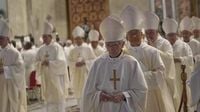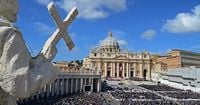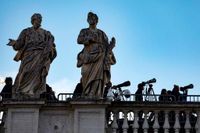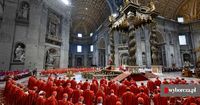On Wednesday, May 7, 2025, cardinals from around the world commenced the conclave to elect a successor to Pope Francis, who passed away on April 21, 2025. The first vote of this historic conclave concluded without a new pope being elected, as indicated by the black smoke rising over the Vatican. Approximately 45,000 people gathered in St. Peter's Square, anxiously awaiting the results of the first vote, which lasted over three hours due to the record number of electors participating—133 in total.
The solemn proceedings began with a Mass Pro eligendo papa in St. Peter's Basilica, presided over by Cardinal Giovanni Battista Re, the Dean of the College of Cardinals. However, neither Re nor his deputy, Cardinal Leonardo Sandri, could participate in the conclave itself, as they both exceed the age limit of 80 years. The responsibility of leading the conclave fell to Cardinal Pietro Parolin, who is also a prominent candidate to succeed Francis.
After the Mass, the cardinal electors participated in a ceremonial procession from the Pauline Chapel to the Sistine Chapel, accompanied by the hymn Veni Creator, invoking the Holy Spirit's assistance. Upon entering the chapel, the electors took an oath to maintain the secrecy of the papal election, pledging to scrupulously observe all regulations as outlined in Pope John Paul II's apostolic constitution, Universi Dominici gregis, announced on February 22, 1996. This oath includes a commitment to protect the confidentiality of the voting process and to resist any external influence on the election.
Once the last elector took the oath, Archbishop Diego Ravelli, the Master of Papal Liturgical Ceremonies, issued the command 'extra omnes' (everyone outside), signaling that only the electors would remain in the Sistine Chapel, while all others had to leave. From that moment on, there would be no contact between the cardinals in the closed chapel and the outside world.
The first vote took place later that afternoon, with a two-thirds majority of 89 votes required to elect a new pope. However, as anticipated, the result was announced with black smoke, indicating that no decision had been reached. The next opportunity for voting would occur the following day, Thursday, May 8, 2025, when the cardinals would have the chance to cast their votes four times—twice in the morning and twice in the afternoon.
The atmosphere in St. Peter's Square was electric, with crowds of around 30,000 people gathered by evening, many waving flags from various countries including Brazil, Argentina, Mexico, the USA, and Poland. The anticipation was palpable as people looked up at the chimney of the Sistine Chapel, awaiting the telltale sign of white smoke that would confirm a new pope had been elected.
In the history of papal elections, the conclave of 2025 marks the third time in just over two decades that cardinals have gathered to choose a new leader for the Catholic Church. The previous conclaves occurred in 2005, following the death of Pope John Paul II, and in 2013, after Pope Benedict XVI's resignation. This conclave is particularly notable due to the unprecedented number of electors, with 80 percent being nominees of Pope Francis.
As the cardinals prepared for the voting process, they faced significant pressure not only from within their ranks but also from the global Catholic community. The decision they were about to make would affect approximately 1.4 billion Catholics worldwide, and the anticipation surrounding who would emerge as the next Bishop of Rome was immense.
Reflecting on past conclaves, both Pope Benedict XVI and Pope Francis have shared their own experiences during the election process. Benedict, elected in 2005, recalled asking God to choose someone stronger than himself, while Francis described feeling a profound sense of peace during his election in 2013, despite the weight of the moment. He was inspired to choose the name Francis after being reminded by Brazilian Cardinal Claudio Hummes to not forget the poor.
The procedure following a successful election is steeped in tradition. Once a candidate receives the necessary votes, the presiding officer of the conclave will ask, "Do you accept?" If the answer is affirmative, the new pope will then choose a papal name, marking the beginning of a new pontificate. The ballot papers are burned, and white smoke will emerge from the chimney of the Sistine Chapel, accompanied by the ringing of the Vatican bells to announce to the world that a new pope has been chosen.
As the conclave continues, the eyes of the world remain fixed on the Vatican, waiting for the moment when the next spiritual leader of the Catholic Church will be revealed. The conclave is not merely a religious event; it is a significant moment in the history of the Catholic Church, drawing attention from millions worldwide, eager to witness the unfolding of this pivotal chapter.




![Konklawe 2025 trwa. Jest 4 polskich kardynałów [PROCEDURA krok po kroku]](https://thumbor.evrimagaci.org/DZaFpkOTiG7QG82Dyd3HeP8hJNE=/200x0/tpg%2Fsources%2F8fc38a24-a8fc-41f7-b2da-942ebcd8600d.jpeg)
